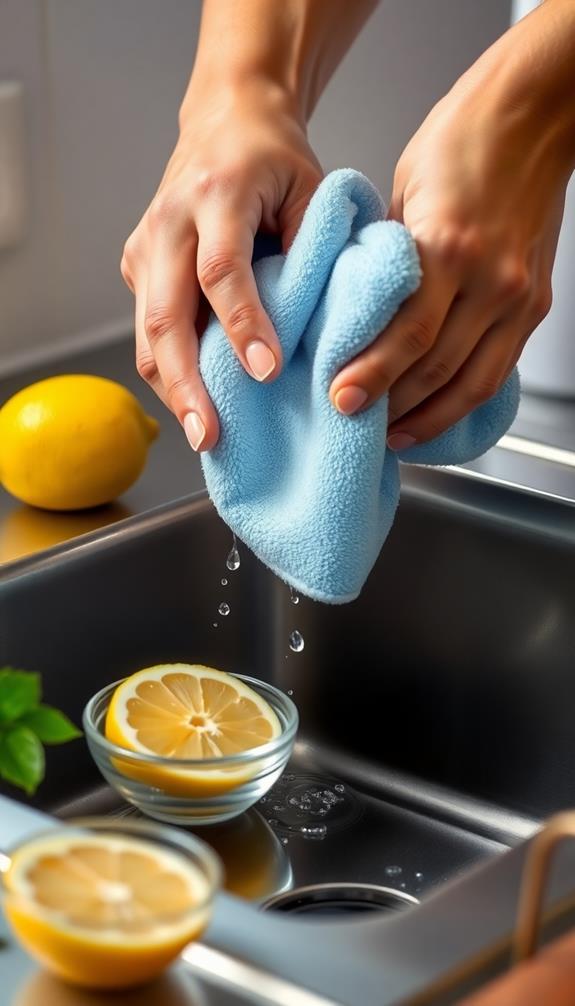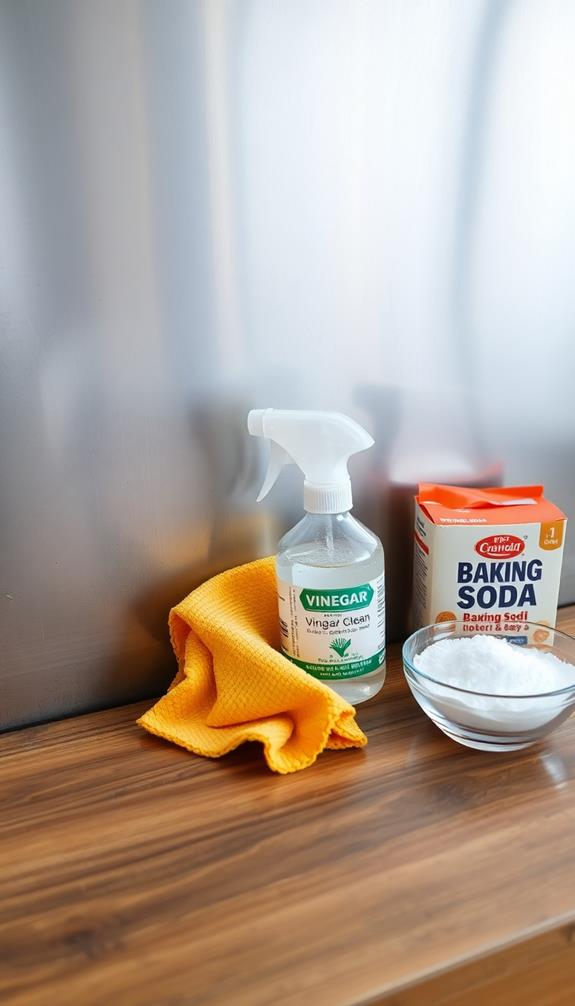To remove water stains from stainless steel, start by mixing equal parts white vinegar and water in a spray bottle. Spray the solution on the affected areas, let it sit for a few minutes, then wipe with a microfiber cloth. For tougher stains, create a paste from baking soda and water, apply it, and scrub gently. Rinse with clean water to eliminate residue and dry completely. Regular maintenance is key, so wipe surfaces down promptly to prevent future stains. If you're curious about additional tips and methods, there's plenty more to discover on keeping your stainless steel spotless!
Understanding Water Stains
Water stains on stainless steel can be a common annoyance, especially if you have hard water in your area.
These stains are mainly caused by high mineral content, such as calcium and magnesium, found in hard water. When the water evaporates, it leaves behind unsightly deposits that appear as white, cloudy spots or streaks on your stainless steel surface.
Regular maintenance with natural cleaning agents can greatly reduce these stains, making cleaning more efficient. Over time, these water spots can accumulate, making your appliances look less appealing.
While hard water stains don't affect the functionality of your stainless steel appliances, they do detract from their visual charm.
Regular maintenance and cleaning can greatly reduce the buildup of these stains, helping you keep your stainless steel looking pristine. Understanding the nature of water stains is essential for effective cleaning.
Essential Cleaning Materials
To effectively tackle water stains on stainless steel, you'll need a few essential cleaning materials that make the job easier and more efficient. Gathering these items will prepare you for a successful cleaning session.
Utilizing natural cleaning agents, such as vinegar, not only helps in removing stains but also promotes a healthier indoor environment by reducing reliance on harsh chemicals natural cleaning solutions.
- White vinegar: This natural cleaning agent's acidic properties help dissolve hard water stains.
- Baking soda: Mix it with water to create a gentle paste for tougher stains without scratching the surface.
- Microfiber cloth: Use this non-abrasive cloth for applying your cleaning solutions and drying, as it traps dirt and moisture effectively.
- Clean cloth: Have a separate clean cloth handy for final wipes after cleaning to avoid any residue.
- Olive oil: Optional, but great for polishing after cleaning. It provides a protective layer that enhances shine and helps prevent future stains.
You might also consider a stainless steel cleaner in a spray bottle for easy application.
Step-by-Step Cleaning Methods

Now that you have your cleaning materials ready, it's time to get started on removing those pesky water stains from your stainless steel surfaces.
Begin by creating a cleaning solution with equal parts white vinegar and clean water in a spray bottle. This eco-friendly solution is effective for breaking down mineral deposits and maintaining the shine of your stainless steel.
For a more robust approach, mix 1/4 cup baking soda with 1/2 cup water to form a paste. Apply this paste to the stains, then spray white vinegar on top to activate the foaming action—it's one of the best ways to remove tough water stains.
Alternatively, you can use a cut lemon, rubbing the juice directly onto the stains. Again, let it sit for 5-10 minutes before gently scrubbing with a microfiber cloth, always moving in the grain direction of the stainless steel.
After scrubbing, rinse the area thoroughly with clean water to remove any residue. Finally, dry the surface completely with a clean microfiber cloth to prevent new stains from forming.
Regularly wipe down surfaces to maintain that polished appearance and consider using effective cleaning methods to keep your appliances looking new.
Preventive Maintenance Tips
Maintaining the pristine look of your stainless steel surfaces doesn't have to be a chore; just a few simple habits can make all the difference. By adopting a routine of preventive maintenance, you can easily avoid water stains and keep your appliances looking their best.
Regular cleaning with warm, soapy water or a gentle vinegar solution is also essential to extend the lifespan of your appliances and prevent dirt buildup, ensuring they shine brightly consistent cleaning helps avoid dirt and grime buildup.
Here are some effective tips to keep your stainless steel surfaces in top shape:
- Regularly wipe down surfaces with a damp microfiber cloth to prevent hard water stains and mineral buildup.
- Use a mixture of equal parts white vinegar and water as a preventive spray to maintain a spotless finish.
- Apply an oil-based stainless steel cleaner monthly to create a protective barrier against moisture and stains.
- Establish a daily cleaning routine to address spills and splashes immediately, which helps maintain appearance and prevents stains from setting in.
- Avoid using abrasive cleaning tools or harsh chemicals that can scratch the surface, making it more prone to stains.
User Experiences and Recommendations

Many users have shared their successful experiences with natural solutions for removing water stains from stainless steel. A popular choice is a vinegar and water solution, which many found effective after just a few minutes. This aligns with the benefits of using non-toxic cleaners, as they can effectively tackle stains while maintaining a safe environment for your family and pets.
If you're tackling tougher stains on stainless steel, consider combining baking soda with vinegar. The foaming action not only lifts the deposits but also makes the process more efficient. Non-toxic cleaning solutions aren't only effective but also promote sustainable living.
Users also rave about lemon juice, noting its dual benefit of removing stains while leaving a fresh scent behind. To achieve the best results, you might experiment with different methods. For instance, start with vinegar to remove the water stains, then follow up with a little olive oil applied with a microfiber cloth for a polished finish.
Interestingly, many individuals have expressed dissatisfaction with commercial cleaners. They found that natural solutions like vinegar and baking soda aren't only more effective in removing water stains but also cost-efficient.
Conclusion
Now that you're armed with the knowledge to tackle those pesky water stains, your stainless steel surfaces can shine like a beacon in the night. By following the steps outlined and taking proactive measures, you'll keep your appliances looking brand new. Remember, a little maintenance goes a long way in preserving that sleek finish. So roll up your sleeves, grab your cleaning supplies, and transform dull into dazzling with just a bit of effort!